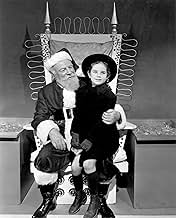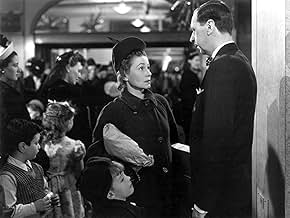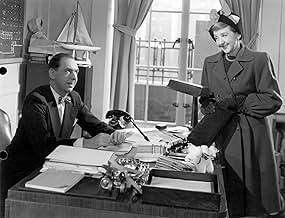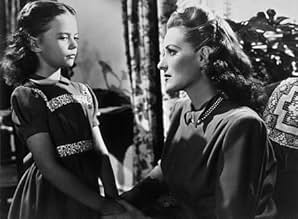After a divorced New York mother hires a nice old man to play Santa Claus at Macy's, she is startled by his claim to be the genuine article. When his sanity is questioned, a lawyer defends h... Read allAfter a divorced New York mother hires a nice old man to play Santa Claus at Macy's, she is startled by his claim to be the genuine article. When his sanity is questioned, a lawyer defends him in court by arguing that he's not mistaken.After a divorced New York mother hires a nice old man to play Santa Claus at Macy's, she is startled by his claim to be the genuine article. When his sanity is questioned, a lawyer defends him in court by arguing that he's not mistaken.
- Won 3 Oscars
- 10 wins & 1 nomination total
- Mr. R.H. Macy
- (uncredited)
- Courtroom Spectator
- (uncredited)
- Mrs. Shellhammer
- (uncredited)
- Courtroom Spectator
- (uncredited)
- Judge's Clerk
- (uncredited)
- Child on Santa's Lap
- (uncredited)
- Secretary
- (uncredited)
- Department Store Head
- (uncredited)
- Director
- Writers
- All cast & crew
- Production, box office & more at IMDbPro
I love movies like this for the insight they provide into the customs of a lost era. Watch the clothing - everybody is so dressed up! - women in dresses, gloves, and hats, men in hats and suits. Notice that when O'Hara enters a room filled with Macy's executives, even though they are the bosses and she is lower management, they all stand up instantly.
The social satire, most on display in the courtroom scenes, also is very 1940s. Apparently audiences of that era took a kind of genial corruption in the judicial system in stride. Business leaders, like "Mr. Macy" were expected to be sharp and profit-oriented, but also decent people like the rest of us. It's a much more nuanced view than the "businessman as criminal villain" so common in today's movies.
The character played by Maureen O'Hara probably needs explanation for modern viewers. Late 1940s audiences knew that the social and economic situation of a divorced working woman with a child was much more precarious than it is now. Divorce was still somewhat shocking - this is brought out neatly in the movie when her would-be lover does a double take when he learns from her daughter about the divorce - he probably had assumed she was a war widow. Divorced moms were still rare in the middle classes. Society universally agreed that women should stay home to raise their children. Economically, women in management positions were still very rare, couldn't expect promotion, and were last hired, first fired. I think O'Hara's performance brings out these qualities in a way that the audience of the 1940s would have understood easily. The character's stiffness, fear of losing control, and anxiety about her job make a great deal of sense. It would have been nice to see a few scenes showing her loosening up, perhaps at dinner with her boyfriend; no doubt those got left on the cutting room floor.
I really like the scene where Santa talks to the little Dutch orphan. First, this scene also must have resonated with the audience; in 1947 the western European countries had only started to recover from World War II, and probably many Americans were familiar with the idea of adopting a war orphan, just as many sent CARE packages. Second, by making Santa fluent in Dutch, the writer cleverly left the viewer thinking that hey, he might really be Santa Claus (isn't Santa Claus fluent in all languages)?
Some reviewers don't like the acting and think that modern actors are "better". I think the older actors aren't better or worse, just different. The audiences of the 1940s expected a certain style of acting, and the directors and actors gave that to them. Then as now, Hollywood paid top dollar and got very talented people, but like all of us they were shaped by their own time and place, more particularly the requirement to make movies that audiences would like. Move Maureen O'Hara to 2004, or Tom Cruise to 1947, and you'd see them acting in the style of that decade.
Storyline
Did you know
- TriviaIn the untranslated dialogue with the Dutch girl, Kris asks her what she wants for Christmas. She says she wants nothing, telling him she got her gift by being adopted by her new mother.
- GoofsKris claims that John Quincy Adams' Vice-President was Daniel D. Tompkins; actually, it was John C. Calhoun. Tompkins served under James Monroe from 1817-1825. The confusion likely occurred because Adams was the 6th President, whereas Tompkins was the 6th Vice-President, as Thomas Jefferson and James Madison had three Vice-Presidents between them.
- Quotes
Mr. Shellhammer: But... but maybe he's only a little crazy like painters or composers or... or some of those men in Washington.
- Crazy creditsThe film's credits do not contain the standard "All characters and events are fictional..." disclaimer, leaving many people to believe that this was a true story.
- Alternate versionsAlso available in two computer colorized versions. The film was first colorized in 1985 by Color Systems Technology, Inc. and again in 2006 by Legend Films using much-improved technology. Prints came with a disclaimer: "It has been altered without the participation of the principal director, screenwriter and other creators of the original film."
- ConnectionsFeatured in The Screen Writer (1950)
- SoundtracksJingle Bells
(1857) (uncredited)
Written by James Pierpont
Played at the announcement of the parade
Played occasionally in the score
Sung a cappella a bit by Percy Helton and later by Jack Albertson
- How long is Miracle on 34th Street?Powered by Alexa
Details
- Release date
- Country of origin
- Languages
- Also known as
- The Big Heart
- Filming locations
- 24 Derby Road, Port Washington, Long Island, New York, USA(Susan's dream house)
- Production company
- See more company credits at IMDbPro
Box office
- Gross worldwide
- $3,851
- Runtime1 hour 36 minutes
- Color
- Aspect ratio
- 1.37 : 1
Contribute to this page








































